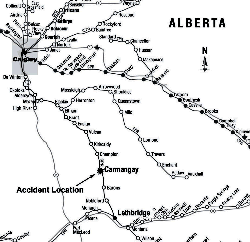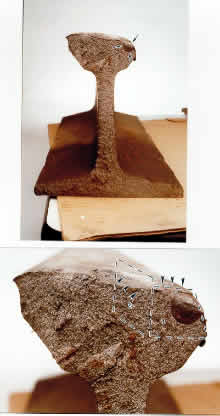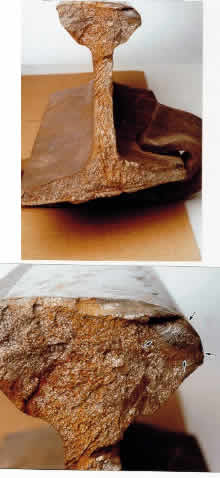Derailment
Canadian Pacific Railway
Freight Train 275-03
Mile 30.2 Aldersyde Subdivision
Carmangay, Alberta
The Transportation Safety Board of Canada (TSB) investigated this occurrence for the purpose of advancing transportation safety. It is not the function of the Board to assign fault or determine civil or criminal liability. This report is not created for use in the context of legal, disciplinary or other proceedings. See Ownership and use of content. Masculine pronouns and position titles may be used to signify all genders to comply with the Canadian Transportation Accident Investigation and Safety Board Act (S.C. 1989, c. 3).
Summary
On 03 March 2002, at approximately 1730 mountain standard time, Canadian Pacific (CP) southward freight train number 275-03 derailed 10 loaded freight cars at Mile 30.2 of the Aldersyde Subdivision, near the village of Carmangay, Alberta. Approximately 90 tonnes of ammonium nitrate and 10 tonnes of potash were spilled. The spilled product was recovered. There were no injuries.
Ce rapport est également disponible en français.
Factual information
On 03 March 2002, at 1310 mountain standard time (MST)Footnote 1, Canadian Pacific (CP) freight train number 275-03 (the train) departed Alyth Yard, Calgary, Alberta, and proceeded southeast destined for Lethbridge (see Figure 1). En route, it passed by three hot box and dragging equipment detectors and no anomalies were reported.
At approximately 1730, as the train proceeded on the main track and was passing over the Carmangay siding north turnout (the Carmangay turnout), Mile 30.2 of the Aldersyde Sbdivision, the train experienced a train-initiated emergency brake application and the locomotive engineer observed rail cars derailing to the west side of the track. At the time of the accident the locomotive event recorder indicated that the train speed was 26 mph, the throttle was in position No 3 and the train brakes were released. After conducting the necessary emergency procedures, the crew determined that 10 cars (17th through to the 26th) had derailed.
Of the 10 derailed cars, seven were tank cars containing propane (UN1075), two were covered hopper cars carrying ammonium nitrate (UN1942), and one was a covered hopper car carrying potash. Five tank cars and three covered hopper cars were destroyed. The other derailed cars were repaired. Approximately 10 tonnes of potash and 90 tonnes of ammonium nitrate were spilled; no propane was released. About 500 feet of track was destroyed.
Propane is a highly flammable gas, used as a domestic and industrial fuel and as a feedstock for the chemical industry. Contact with propane may cause burns, severe injury, frostbite or death. It is easily ignited by heat, sparks or flames and, if released, will travel to the source of ignition and flashback.
Ammonium nitrate is a colourless crystalline product, usually used as a fertilizer, an explosive, or a herbicide and insecticide. It may react explosively with hydrocarbons. When mixed with hydrocarbons, it can become an explosive such as ANFO (Ammonium Nitrate Fuel Oil). A detonation source would still be required to cause an explosion. It accelerates burning when involved in a fire and may produce irritating, corrosive and poisonous gases. Runoff from fire control or dilution in water may pollute waterways.
The clean-up of the accident site began the next day. As the spill site was located approximately 750 feet south and 450 feet east of the Little Bow River, a silt barrier was constructed in the ditches to prevent any spilled material from reaching the river during the spring run-off. The propane was transferred to other tank cars. All of the spilled ammonium nitrate and potash were recovered.
The temperature at Claresholm, the closest weather station to Carmangay, at the time of the derailment was minus 6.4 degrees Celsius with light easterly winds. The sky was clear and visibility was good. Five of the preceding eight days had temperatures of minus 21 degrees Celsius or less.
The train consisted of 2 locomotives and 54 cars (50 loaded, 4 emptied). It weighed 6515 tons and was 3612 feet long. The crew members (a conductor, a trainman and a locomotive engineer) were qualified for their respective positions and met fitness and rest standards designed to ensure the safe operation of trains.
The locomotives and the first 16 cars from the head end were taken to Lethbridge Yard for a full mechanical inspection. No defects were found.
Train movements on the Aldersyde Subdivision are governed by Occupancy Control System rules authorized by the Canadian Rail Operating Rules and controlled by a rail traffic controller located in Calgary.
On average, six trains per day operate on the Aldersyde Subdivision. Twelve million gross tons (mgt) are hauled annually.
The Aldersyde Subdivision is a single main track that extends from Mile 2.9 (Lethbridge, Alberta) to Mile 86.6 (Aldersyde, Alberta). The maximum authorized timetable speed was 45 mph for freight trains. At the time of derailment, there was a general bulletin order restricting train speeds to 25 mph from Mile 10.5 to Mile 39.1 and to 10 mph from Mile 26.0 to Mile 28.5 due to narrow gauge conditions caused by broken single shoulder tie plates.
Through the derailment area, the track is tangent and ascends at a 0.32 per cent gradient in the direction of train travel. It consists of 100-pound per yard jointed rail manufactured in 1947, laid on No 1 softwood ties and anchored every tie. In 2001, the single shoulder tie plates were replaced with doubled-shoulder tie plates between Mile 28.5 and Mile 30.2. The ties were in good condition and laid in crushed rock ballast with full cribs and 12-inch shoulders. The track is located on a 10-foot fill with good drainage. The roadbed was frozen and the ground surface was snow covered.
The rail was fractured near a rail joint located in the main track west rail, approximately 110 feet south of the switch point of the Carmangay turnout. South of the fractures, the rail was destroyed for approximately 500 feet. There were no marks on the track or roadbed north of the broken rail to indicate that equipment failure (ie. broken wheel or axle) had occurred. Sixteen pieces of the fractured rail were recovered and sent to the TSB Engineering Laboratory for examination.
The TSB Engineering Laboratory report (No. LP 16/02) noted the following:
- Two of the rail pieces had fracture surfaces which contained progressive transverse defects on the gauge side of the rail, comprising approximately five and three per cent of the fractured surface area (see Photos 1 and 2).
- Significant surface defects (surface cracking, material flow, shelling, flaking) were observed along the gauge side of the rail pieces.
- The transverse defects initiated from surface cracks (surface defects) on the gauge side of the rail. There were no impact marks.
- Wear measurements indicated that the rail was just within maximum allowable wear limitsFootnote 2. The rail head had lost 26 per cent of its original surface.
- No material deficiencies which could have contributed to the failure of the rail were identified.
The Aldersyde Subdivision track was inspected visually twice per week, at least semi-annually by a track geometry car, and three times per year with a rail flaw detector car. A visual turnout inspection was performed monthly and a detailed turnout inspection carried out semi-annually.
In the Carmangay area, the last visual inspection of the track was conducted by the track maintenance foreman (TMF) on 01 March 2002; no irregularities were noted. The turnout was last inspected by the TMF on 14 February 2002 and was reported to be in a satisfactory condition. Rail surface defects were not noted during monthly visual inspections as there are no provisions in the report to record them. The last track geometry car inspection was carried out on 13 September 2001; no defects were identified. The last ultrasonic and induction inspection was conducted on 16 January 2002; no internal defects were detected. However, a signal response recorded at Mile 30.2 was indicative of surface defects.
The minimum performance specification expected by CP for detecting transverse defects is to identify at least 65 per cent of all defects between 5 per cent and 10 per cent of the rail head areaFootnote 3. There is no requirement to detect transverse defects less than 5 per cent of the rail head area. However, transverse defects as small as 3 per cent of the rail head area can be detected, providing that surface defects, such as shelling, flaking, and surface cracking, are not present on the rail surface.
On the Aldersyde Subdivision, CP carries out grinding on the rail generally every 12 to 15 mgt and on turnouts and crossings every four years or approximately every 48 mgt. The last switch-and-crossing grinding program was undertaken during 1998, but grinding of the Carmangay turnout was not performed due to a potentially extreme grass fire hazard.
In August 2001, maintenance work was performed between Mile 28.5 and Mile 30.2 to correct the narrow track gauge. The ties were adzedFootnote 4 and the broken and worn out single shoulder tie plates were replaced with 14-inch double-shoulder tie plates. The double-shoulder tie plates reduced the cant on the rails, correcting the narrow gauge condition and realigning the wheel-to-rail contact points toward the gauge side of the rail head.
Analysis
There is no information to indicate that train operation or the mechanical condition of the equipment contributed to the accident. The derailment occurred when the rail broke under the load of the train. The analysis will focus on the cause of the rail break, the formation of the fractures, and the maintenance and inspection methods used to mitigate the risks associated with transverse defects.
There was no indication from the examination of the train wheels that an excessive load impact had caused the rail failure to occur. In addition, there was no indication that a material defect had contributed to the failure of the rail. The transverse defects were initiated on the gauge side surface of the rail. When double-shoulder tie plates were installed, and the rail cant was reduced, the contact stresses from wheel loading shifted onto the gauge side of the rail, accelerating the propagation of surface cracks. Further development of the surface cracks, and the excessive rail head wear, reduced the ability of the rail section to resist crack growth. Subsequently, surface cracks formed subsurface cracks that turned downward and developed into two transverse defects. Rail failure occurred when these transverse defects reached a critical size.
Although the two transverse defects represented up to five per cent of the total rail head fracture surface, they were likely smaller when the rail flaw detector car carried out ultrasonic and induction tests 46 days prior to the accident. Reliability of the testing equipment to detect small internal defects is reduced when surface defects are present. Surface defects were present on the rail surface in 1998, when a grinding program was scheduled, and had propagated since then. When the rail flaw detector car tested the track in 2002, surface defects concealed the presence of transverse defects. A grinding program would reduce the size and the amount of surface defects. In the absence of such a program, surface defects are not corrected and reduce the ability of a rail flaw detector car to detect internal rail defects. The surface defects could also continue to grow, develop into transverse defects, and lead to derailments.
During visual inspections of the Carmangay turnout, there are no provisions in the inspection report to record surface defects. However, if the inspector deems them significant, they can be noted in the "Additional Comments" section of the semi-annual detailed inspection report. Because there were no inspection criteria for surface defects, remedial grinding of the rail was not deemed necessary and consequently, the propagation of the surface defects was not stopped.
As all of the spilled products were recovered, the environmental impact of the accident was minimal. Cold temperatures reduced the likelihood of leaching or run-off. Confinement and control of the dangerous goods, and the clean-up and control of the derailment site, were carried out in a timely and effective manner.
Findings
Findings as to causes and contributing factors
- The derailment occurred when the rail broke under the load of the train.
- The rail failed when surface defects propagated to transverse defects and reached a critical size.
- When double-shoulder tie plates were installed, the wheel contact stresses shifted onto the gauge side of the rail, accelerating the propagation of surface cracks.
- Because there were no inspection criteria for surface defects, remedial grinding of the rail was not deemed necessary and consequently the surface defects were not corrected and developed into transverse defects.
Findings as to risk
- In the absence of a grinding program, surface defects are not corrected and reduce the ability of a rail flaw detector car to detect internal rail defects.
Other findings
- Confinement and control of the dangerous goods, and the clean-up and control of the derailment site were performed in an expedient and professional manner.
Safety action taken
Canadian Pacific initiated a switch-and-crossing grinding program in May 2002 and completed the grinding of all the main track switches on the Aldersyde Subdivision.
This report concludes the Transportation Safety Board's investigation into this occurrence. Consequently, the Board authorized the release of this report on .


